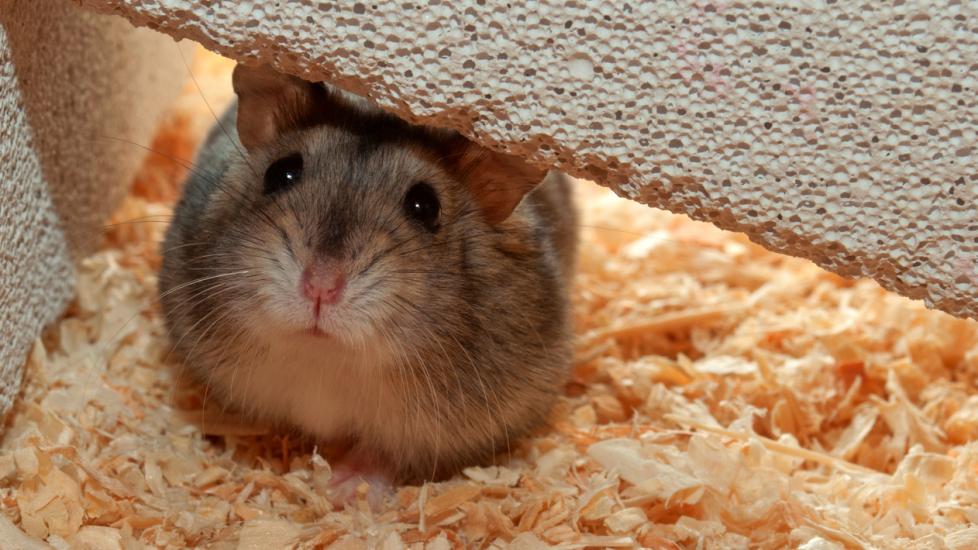Hair Loss in Hamsters
What is Hair Loss in Hamsters?
Hair loss in hamsters is a common issue and can happen for many reasons. Hair loss can be due to hair falling out, failure of hair to grow, or “barbering” of hair or other traumas that break the hair off at the base. The term for all of this is called alopecia.
Symptoms of Hair Loss in Hamsters
Signs of alopecia in hamsters include:
-
Thinning hair
-
Patches of hair loss
-
Patches of short hair
-
Scabbing
-
Dandruff
-
Lethargy
Causes of Hair Loss in Hamsters
Just like in humans, there are lots of different reasons for hair loss in hamsters. The pattern of the loss and anything else that might be happening can narrow down the cause, including:
-
Age Related: this can also be stress related as hamsters are more susceptible to stressors as they age
-
Environmental Trauma: rubbing certain parts of the body on parts of the cage or fitting into spaces to burrow can cause hair loss
-
Barbering: cage mates excessively grooming or chewing on hair can cause hair thinning, short hairs, or bald patches
-
Nutritional: low levels of certain nutrients like proteins or some vitamins or minerals can cause hair loss
-
Ectoparasites: infections of things like mites, lice, ringworm, and more can cause hair loss
-
Thyroid Levels: though more rare, low thyroid levels can lead to hair loss or thinning
-
Organ Disease: organ disease but especially kidney disease can lead to hair loss over time
-
Cancers: a special type of lymphoma can affect the skin in hamsters and cause hair loss
How Veterinarians Diagnose Hair Loss in Hamsters
Finding out why a hamster has hair loss can be a bit of a process. Your veterinarian will start with identifying what type of hair loss is present. They may ask questions such as:
-
Is the hair there but shorter?
-
Are whole patches missing hair entirely or has the coat only thinned out?
-
Do the hairless patches have any other symptoms such as redness, scabbing, flaking, pain, etc.?
-
Is the pet itchy?
-
Where is the hair loss?
Based on the answers to these questions, your vet will then choose to run any number of potential tests including:
-
Skin Scrape: scraping at the top layer of the skin to exfoliate the cells and transferring them onto a slide to check for ectoparasites under a microscope
-
Tape Prep: using a small piece of clear tape to collect skin cells, hair, and other debris from parts of the hamster around the lesion and transferring them onto a slide to check for ectoparasites under a microscope
-
DTM gel or a Ringworm PCR: collecting hair from around the lesion to either apply to a special type of gel and monitor for two weeks or send to a lab to run a specialized test to screen for ringworm
-
Blood tests: checking for signs of nutritional imbalances, thyroid issues, organ disease, cancers, infections and more
Treatment of Hair Loss in Hamsters
Treatments can vary wildly depending on the issue identified by your veterinarian.
For stress or cage mate related hair loss, controlling stressors and access from cage mates can solve the issue. The same goes for environmental trauma, where certain parts of a cage may need to be removed or blocked if the hair loss is an issue.
A thorough review of your hamster’s diet may lead to some adjustments if nutritional based alopecia is suspected.
Treatment for ectoparasites depends on the type but usually consists of some combination of oral and/or topical medications, possibly including medicated baths.
Treatment for low thyroid levels can include thyroid supplementation medication.
Organ dysfunction can potentially be treated depending on the organ and requires a full workup first.
Cancers that cause hair loss in hamsters are unfortunately not treatable, though palliative medication may be given.
Recovery and Management of Hair Loss in Hamsters
Regardless of the cause of the hair loss, in these cases it is always important to deeply clean and disinfect your hamster’s cage, all toys and hides inside, and replace all bedding. You’ll want to maintain a clean cage and control environmental stressors throughout treatment. Some hamsters with cage mates may need to be separated from the others in the event of a contagious reason for hair loss such as an ectoparasite.
Lack of treatment for hair loss can lead to skin infections, self-trauma, anemia, loss of appetite, and more so always be sure to take you hamster to a vet when symptoms are noticed and notify your veterinarian if they aren’t responding to treatment.
Prevention generally includes maintaining good care and not exposing your hamster to other hamsters or rodents. Other rarer reasons for hair loss may be influenced mostly by genetics. The best way to handle those cases is to take your hamster to a vet for a workup soon as symptoms are noted rather than waiting.
Hair Loss in Hamsters FAQs
Why is my hamster losing hair?
There are many possible reasons for this. You’ll want to take your hamster to a veterinarian upon noting hair loss so they can narrow down if this is related to their environment, their diet, underlying disease, parasites, or other causes.
How long do bald patches last?
Bald patches can take 4-6 weeks to regrow after treatment, sometimes longer in hamsters with other underlying conditions.
Do bald patches ever grow back?
Yes! Depending on the cause and if it has been treated, most bald patches can grow back after undergoing treatment. Only some are permanent.
References
Help us make PetMD better
Was this article helpful?
